If you enjoy gourmet and specialty mushrooms, you may have noticed that the price for these mushrooms can get pretty pricey, especially if the species is difficult to cultivate or forage. So, what are the 10 of the most expensive mushrooms in the world currently?
Well, in this guide, we’ll answer this question and provide some information on each of our picks such as whether the mushroom can be easily foraged or cultivated, where it grows, and for our top three, why they’re so expensive.
So, without further ado, let’s dive in!
Our Top 10 Picks of The Most Expensive Mushrooms
The first five on our list are some of the most expensive but commonly found gourmet grocery store mushrooms in the US, and the remainder are harder to find and much more expensive. The top 10 most expensive mushrooms per pound, listed in descending order from least to most expensive, are:
10. Oyster Mushrooms
9. Beech Mushrooms
8. Lion’s Mane Mushrooms
7. Shiitake Mushrooms
6. Chanterelle Mushrooms
5. Morel Mushrooms
4. Porcini Mushrooms
3. French black truffles
2. Alba white truffles
1. Caterpillar Mushrooms
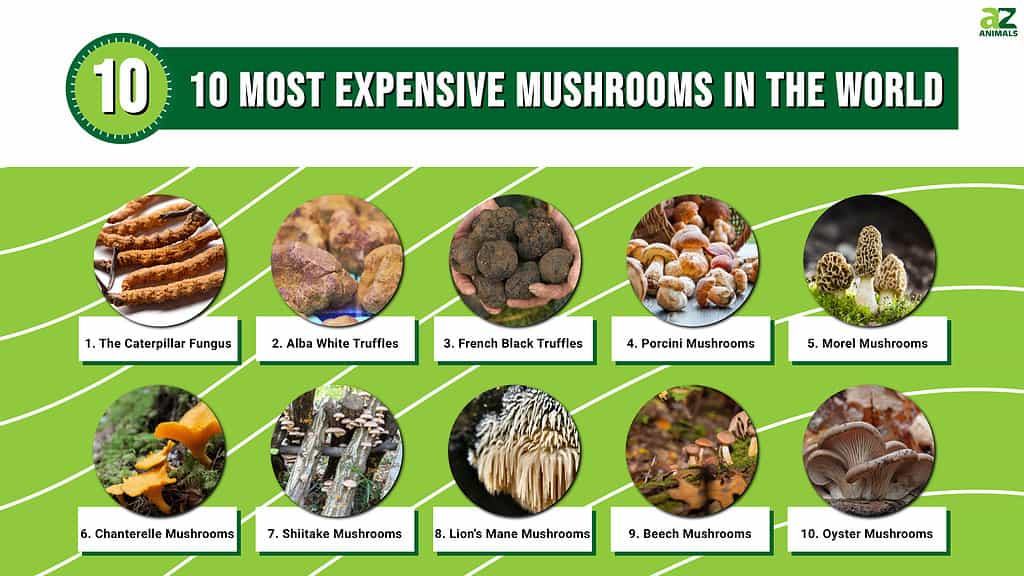
10. Oyster Mushrooms
As the third most cultivated mushroom in the world, oyster mushrooms represent a significant portion of the world’s edible mushroom market. Although they are increasing in popularity worldwide, these mushrooms are still several times more expensive than the average button mushroom (Agaricus bisporus), which currently still dominates Western markets. Compared to the white button mushroom’s average retail price per pound of $1.45, oyster mushrooms sell for about $10-12 per pound fresh.
Oyster mushrooms represent the genus Pleurotus, which currently contains about 200 documented species. All of these species are edible, though some are much more popular. The most widely consumed oysters include wild species and cultivated varieties such as the pearl oyster (Pleurotus ostreatus), the king oyster (Pleurotus eryngii), the golden oyster (Pleurotus citrinopileatus), and the pink oyster (Pleurotus djamor).
Oyster mushrooms are well-loved for their subtle, seafood-like taste and delicate, meaty texture. As a wood-decaying mushroom, these mushrooms are easily cultivated on various species of hardwood logs such as oak, maple, poplar, and aspen. You can also cultivate these mushrooms in grow kits at home in bags of inoculated sawdust and other mediums. Additionally, oyster mushrooms commonly grow across temperate and subtropical forests around the world, making foraging for these delicious fungi rather achievable.
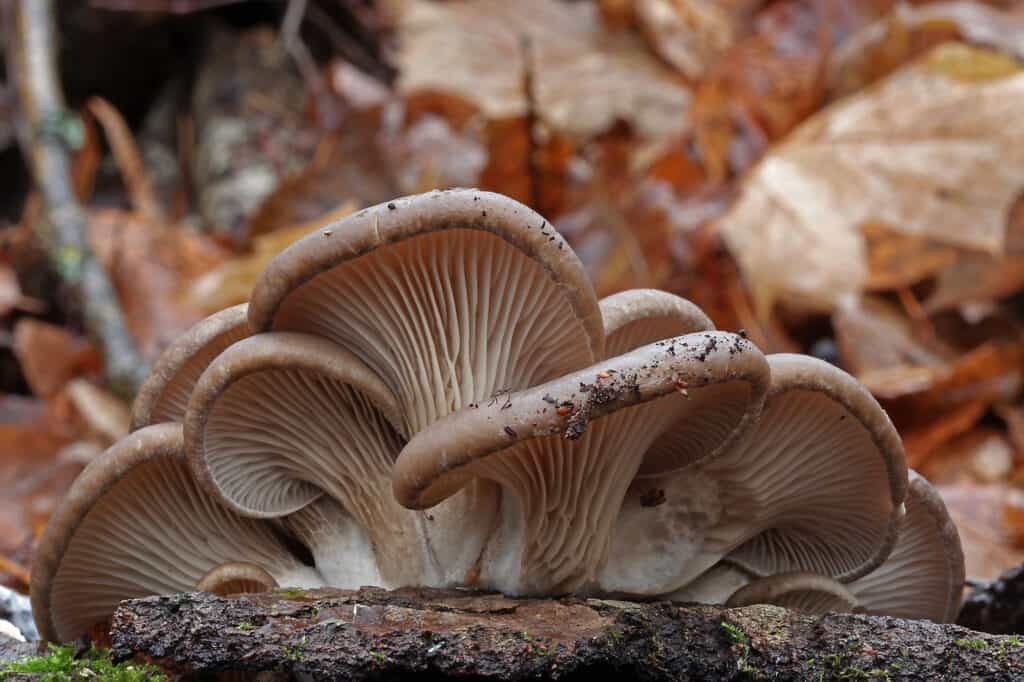
Oyster mushrooms are still several times more expensive than the average button mushroom.
©NK-55/Shutterstock.com
9. Beech Mushrooms
The next mushroom on our list is widely popular across its native growing region of East Asia. The beech mushroom (Hypsizygus tessellatus), while native to temperate regions of East Asia, is becoming more widely cultivated and sold across temperate regions of Europe, Australia, and North America. This mushroom sells in most US retail markets, where it’s still considered a specialty mushroom, for about $13-16 per pound.
This mushroom is prized for its lovely nutty taste and firm, crunchy texture. Both white and brown-capped varieties are commercially grown. The long stalk is used in cooking along with the caps.

The beech mushroom (
Hypsizygus tessellatus) is considered a specialty mushroom and is priced around $13-16 USD per pound.
©Marian Fil/Shutterstock.com
8. Lion’s Mane Mushrooms
Growing in popularity around the world for their culinary and medicinal uses, lion’s mane mushrooms (Hericium erinaceus) are currently available fresh in US retail markets for about $16-18 per pound. These shaggy-toothed mushrooms have a slightly sweet, mild flavor with a texture similar to shellfish like scallops or lobster.
These mushrooms are found growing widely across temperate regions of the Northern Hemisphere. They are both saprobic and parasitic and can be easily cultivated at home in growing kits or by inoculating hardwood logs such as beech, maple, oak, and walnut trees.
Medicinally, Hericium erinaceus is currently popular among medical researchers for its potential use in treating neurodegenerative diseases such as Alzheimer’s and Parkinson’s, and inflammatory bowel diseases such as ulcerative colitis.
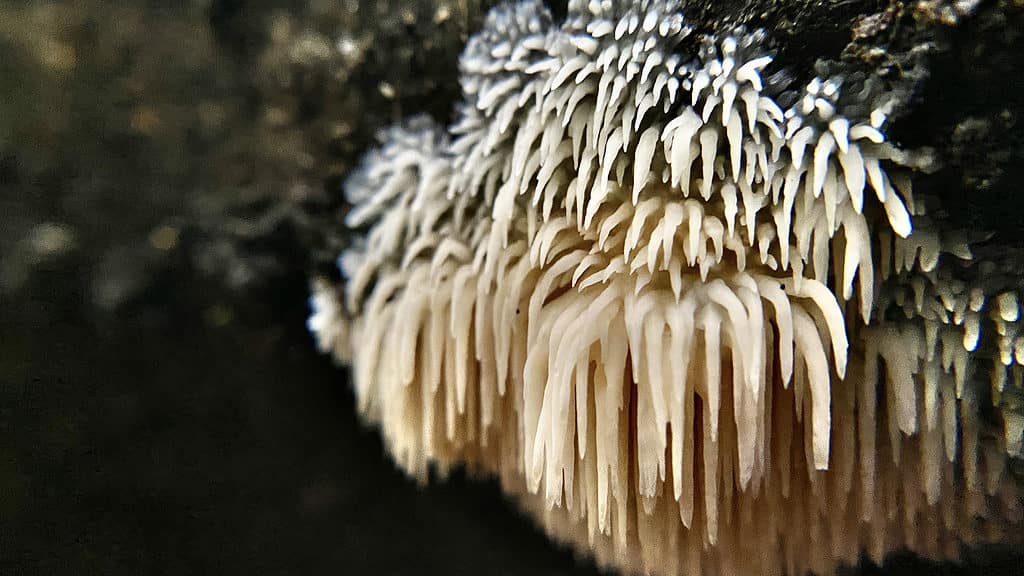
The spiny
lion
‘s mane mushroom has a mild flavor with a texture similar to shellfish and is being explored for its medicinal qualities.
©iStock.com/samuel howell
7. Shiitake Mushrooms
Next up on our list is currently the second most cultivated mushroom in the world, shiitake mushrooms (Lentinula edodes). This mushroom is highly favored for its meaty, buttery texture, and delightfully nutty, smoky flavor. Currently, the average price of fresh shiitake mushrooms in the US is about $15-20.
Shiitake mushrooms are native to East Asia, primarily China and Japan, but are now widely grown in favorable growing conditions around the world. As a wood decayer, shiitake mushrooms are easily cultivated on hardwood logs and in inoculated bags of sawdust and other suitable mediums.
People also highly prize shiitake mushrooms for their medicinal properties. Researchers have studied Lentinula edodes and confirmed immune system stimulation, anti-microbial, anti-viral, and anti-carcinogenic properties in both the fruiting body and mycelium.
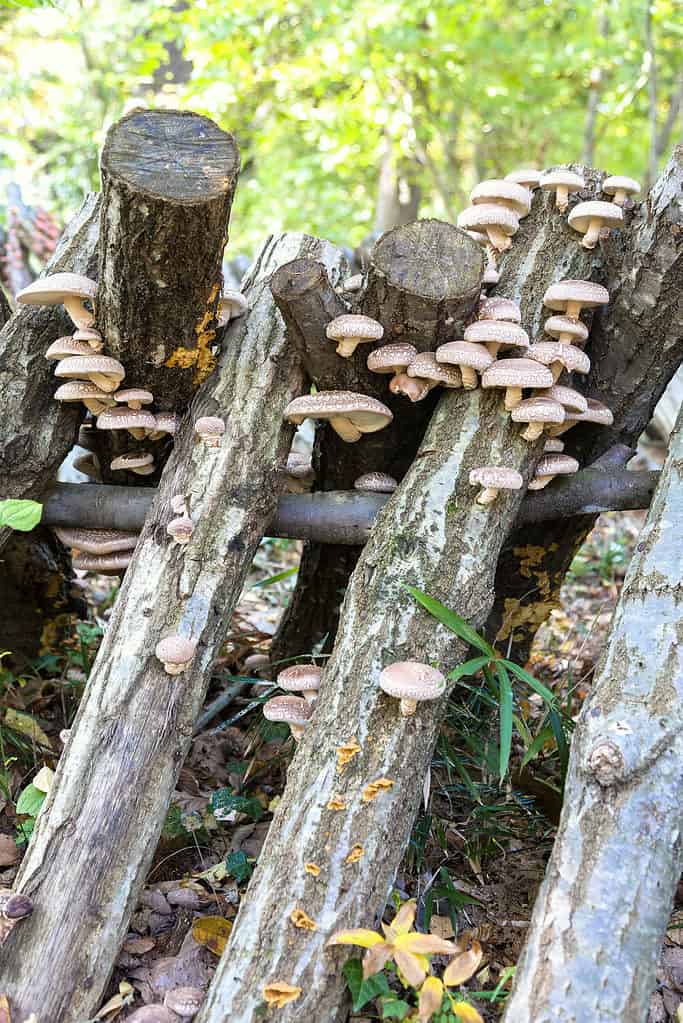
The shiitake mushroom (
Lentinula edodes) is currently the second most cultivated mushroom in the world.
©janken/Shutterstock.com
6. Chanterelle Mushrooms
A favorite among foragers for their sweet, fruity, and nutty flavors, the chanterelle genus contains many choice, edible mushrooms. Currently, in the US, these mushrooms sell fresh in retail markets for about $30-40 per pound. Price can vary depending on the species, and as these mushrooms aren’t commercially cultivated, you can only buy them fresh during the foraging season.
The reason these mushrooms aren’t more expensive since they can’t be cultivated due to their complicated mycorrhizal plant-fungi relationships is that they can be easily found during the foraging season. Chanterelles grow widespread in clusters from late spring through early fall across temperate regions of North and Central America, Europe, and Asia.

Chanterelle mushrooms are popular for their sweet, fruity, and nutty flavors.
©Paula Savelius/Shutterstock.com
5. Morel Mushrooms
Found across temperate regions of North America, Central America, Europe, and Asia, morel mushrooms (Morchella spp.) are a favorite among many foragers who prize this genus of mushrooms for their meaty texture, and earthy, nutty flavors. Currently, in the US, these mushrooms sell fresh for about $35-50 per pound, depending on the market and species.
One of the reasons morel mushrooms are so expensive is that they are rather difficult to cultivate, with the first indoor cultivation model created in 1982. Outdoor commercial morel cultivation operations do exist, primarily in China, but they are not widespread.

Morel mushrooms are expensive because they are difficult to cultivate,
©Mircea Costina/Shutterstock.com
4. Porcini Mushrooms
Porcini mushrooms, also known as king boletes (Boletus edulis), are a species in the bolete family that are loved for their meaty texture and rich, earthy flavor. Currently, these mushrooms are sold in retail markets in the US for about $40-70 per pound, although they are not often found sold fresh online. Typically, porcinis are either sold dried or fresh frozen.
These mushrooms are hard to miss when foraging as they are notably thick, which adds to their value as a mushroom with a meat-like texture. Porcinis are particularly well-loved in Italy, where they are added to stews, pasta, and gravies, and grilled as gourmet sides. As with many expensive mushrooms, these mycorrhizal mushrooms are quite difficult to cultivate, adding to their market value.
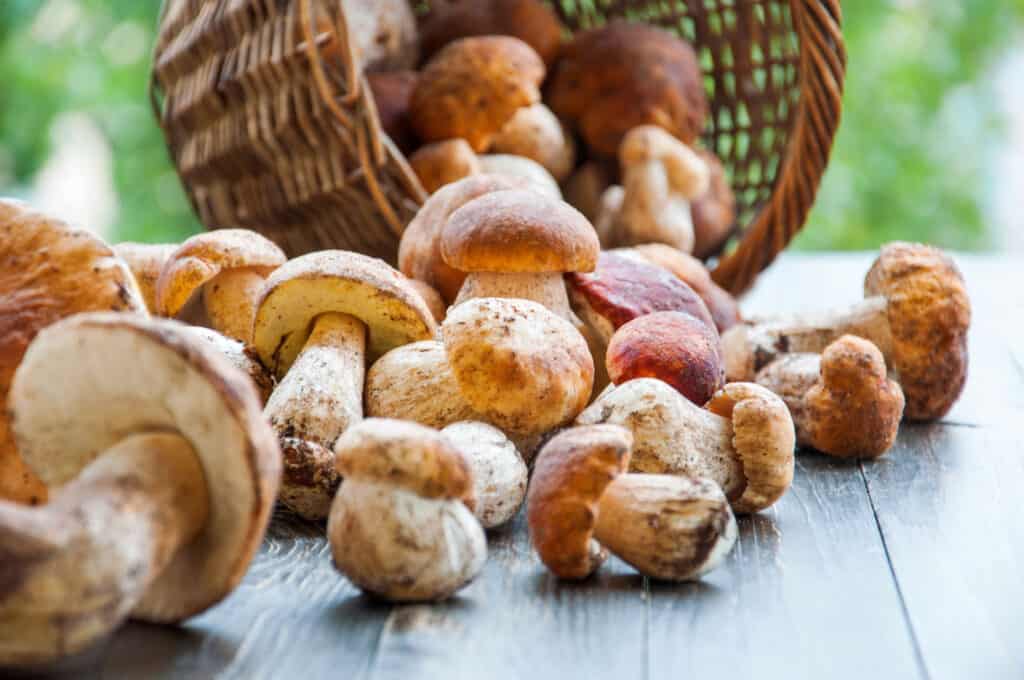
Porcini mushrooms have a meaty texture and rich, earthy flavor and due to their cultivation challenges, are priced quite high.
©All for you friend/Shutterstock.com
3. French Black Truffles
Of course, it likely comes as no surprise that the mushroom to take the number three spot on our list of the 10 most expensive mushrooms in the world is the black truffle. Specifically, we’re talking about the French black truffle (Tuber melanosporum). This mushroom grows primarily in the Burgundy, Dordogne, and Provence regions of France. However, you can also find them growing natively across some areas of Southern Europe. Currently, this luxury mushroom is sold in US retail markets for about $1,000-$2,000 per pound.
Those who can afford to try this delicacy describe the mushroom as having a deep, rich umami taste with a pungent earthy, musky accent. So, what’s the hype about truffles? Why are they so dang expensive? Well, these special fungi have a short foraging season, are difficult and labor-intensive to find, grow in a limited region, and are extremely difficult to cultivate. Additionally, the culture of elitism and scarcity around truffles helps keep the price up.
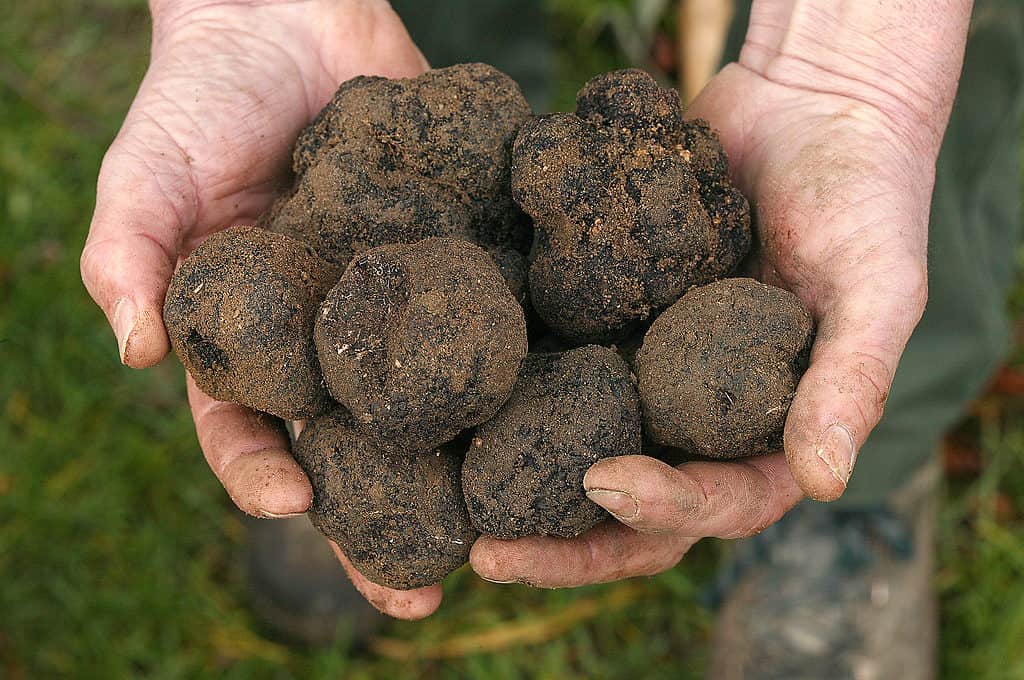
The French black truffle is the third most expensive mushroom in the world due to its short foraging season and labor-intensive harvesting.
©slowmotiongli/Shutterstock.com
2. Alba White Truffles
Now, while the black truffle sells for an exorbitant amount of money, the price of white truffles can reach about four times that amount. This truffle, found growing primarily in the Alba township of Italy, currently sells in the US retail market for about $4,000 per pound.
So, you might be asking why these truffles are even more expensive than their French counterparts. Well, they are even rarer than black truffles with an even more limited native growing region. Additionally, the flavor of this truffle is reported to be unmatched in its complexity and richness.
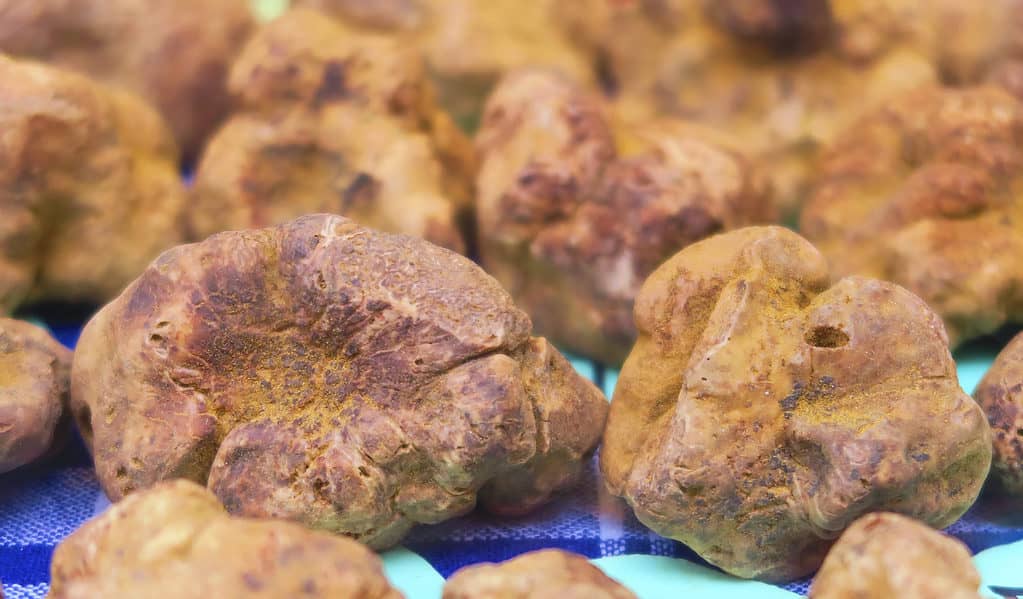
White truffles from Alba are even rarer than black truffles and much more expensive.
©dav76/Shutterstock.com
1. The Caterpillar Fungus
Alright, if the price of the previous mushroom made your jaw drop, you might want to sit down as the cost of our final mushroom is simply staggering. The caterpillar fungus (Cordyceps sinensis) is a parasitic cordyceps mushroom that grows out of dead Tibetan caterpillars (Hepilus fabricius). This fungus infects the caterpillars in the summertime while they are feeding underground, slowly consuming them throughout fall until it forces the infected host to rise toward the surface, where it then sends a fruiting body through the head of Hepilus fabricius.
Traditionally, the dead caterpillar is sold along with the external fruiting body, which means consumers purchase the important mycelium as well. So, what’s the going rate in the US retail market for one dried pound of wild-harvested caterpillar fungi? Well, that generally ranges from $20,000-$50,000 per pound.
Now, what could possibly make this fungus so unbelievably expensive? Well, it’s only found in extremely limited areas in the Himalayan mountains and can not be cultivated. It can only be harvested for a few weeks each year. Buying these strange fungi has also become a status symbol for wealthy collectors around the world.
In addition to its rarity, this fungus has a deep history of folkloric medicine in its growing region. Claimed medicinal benefits include anti-cancer, urinary tract support, aphrodisiac properties, respiratory support, immune support, energizing effects, and more. Essentially, the fungus is folklorically known as a general cure-all.
Current research does potentially support some of the traditional uses of this fungus in medicine by confirming energizing effects, anti-cancer compounds, anti-viral compounds, anti-inflammatory properties, and antioxidant compounds.
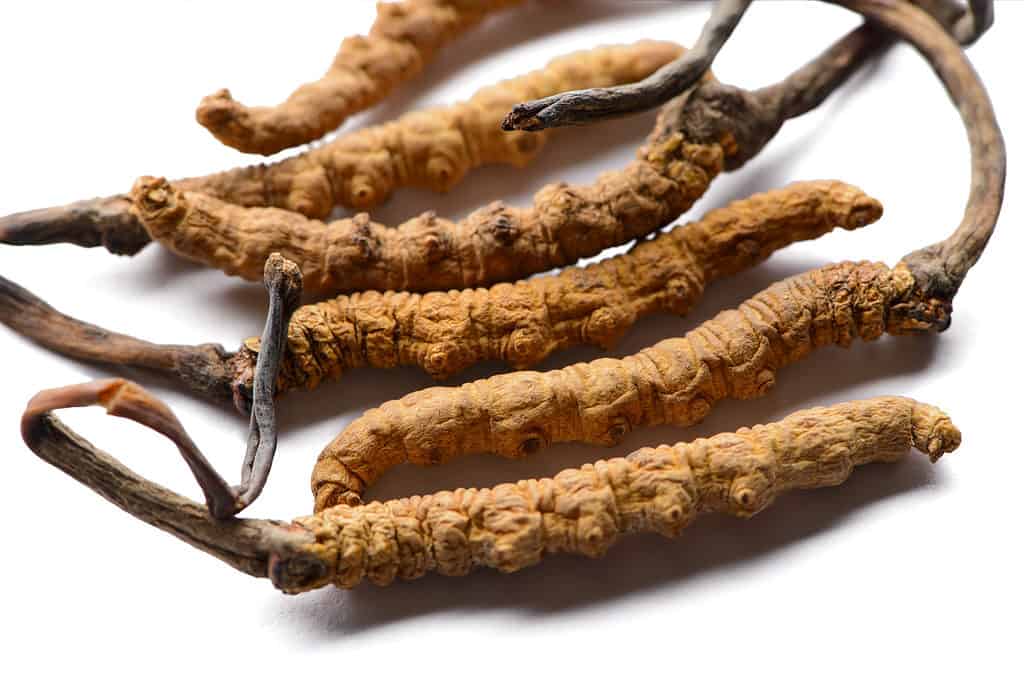
Caterpillar fungus is a parasitic cordyceps mushroom that grows out of dead Tibetan caterpillars and is the most expensive mushroom available.
©iStock.com/Brostock
Expensive Mushrooms That Didn’t Make the List

Matsutake mushrooms are grown under red pine trees in Kyoto, Japan.
©ykokamoto/Shutterstock.com
Out of the 3,000 edible mushroom species, 200 are consumed by humans. These fungi don’t typically have a high cost of production. It is thought that their high prices are due to the difficulty in harvesting them, which can be labor intensive. In addition to the 10 mushrooms mentioned, there are a few additional fungi that deserve mention. The matsutake, the Kalahari truffle, and perhaps the meatiest of all, the portobello.
Of these three, one is extremely rare and even endangered. Let’s take a look at these delicious, prized mushrooms:
- Matsutake – this rare-to-find mushroom has a well-formed cap and short stem. It is grown under red pine trees in Kyoto in the Tamba region of Japan. Due to the trees becoming scarce, these fungi are considered endangered and all efforts to cultivate them artificially have not been fruitful. Has a spicy-aromatic scent similar to cinnamon and tastes spicy and piney.
- Kalahari Truffles – these fungi, which grow in the ground, are considered the least expensive of the truffles and are found in the Kalahari Desert.
- Portobello – this is one of the more common mushrooms that have an earthy flavor that is quite often described as meaty. It is similar to cremini mushrooms, or baby bellas, which are simply a less mature portobello. Their price can go up due to their sensitivity to changes in the environment, which can lead to longer growth rates.
The content on this page is for informational purposes only and may contain inaccuracies. Please verify all information independently. AZ Animals says: do not eat any wild mushrooms or plants without firsthand knowledge that they are safe for consumption.
Summary of the 10 Most Expensive Mushrooms in the World in 2024
| Rank | Mushroom | Special Qualities | Price |
|---|---|---|---|
| 1 | The Caterpillar Fungus | Potent medicinal properties Cannot be cultivated Only available for a few weeks per year. | $20,000-$50,000 per pound |
| 2 | Alba White Truffles | A complex rich flavor found nowhere else A limited native growing region | $4,000 per pound |
| 3 | French Black Truffles | A deep, rich umami taste with a pungent earthy, musky accent | $1,000-$1,500 per pound |
| 4 | Porcini Mushrooms | A meaty texture and rich, earthy flavor | $40-70 per pound |
| 5 | Morel Mushrooms | A meaty texture, and earthy, nutty flavor | $35-50 per pound |
| 6 | Chanterelle Mushrooms | A sweet, fruity, and nutty flavor | $30-40 per pound |
| 7 | Shiitake Mushrooms | Potent medicinal properties A meaty, buttery texture, and a delightfully nutty, smoky flavor | $15-20 per pound |
| 8 | Lion’s Mane Mushrooms | A slightly sweet, mild flavor A texture reminiscent of shellfish | $14-16 per pound |
| 9 | Beech Mushrooms | A lovely nutty taste and firm, crunchy texture | $13-16 per pound |
| 10 | Oyster Mushrooms | A subtle, seafood-like taste and delicate, meaty texture | $10-12 per pound |
The photo featured at the top of this post is © charnsitr/Shutterstock.com
The information presented on or through the Website is made available solely for general informational purposes. We do not warrant the accuracy, completeness, or usefulness of this information. Any reliance you place on such information is strictly at your own risk. We disclaim all liability and responsibility arising from any reliance placed on such materials by you or any other visitor to the Website, or by anyone who may be informed of any of its contents. None of the statements or claims on the Website should be taken as medical advice, health advice, or as confirmation that a plant, fungus, or other item is safe for consumption or will provide any health benefits. Anyone considering the health benefits of particular plant, fungus, or other item should first consult with a doctor or other medical professional. The statements made within this Website have not been evaluated by the Food and Drug Administration. These statements are not intended to diagnose, treat, cure or prevent any disease.
Sources
- Spelman, Kevin & Sutherland, Elizabeth & Bagade, Aravind. (2017). Neurological Activity of Lion’s Mane ( Hericium erinaceus ). Journal of Restorative Medicine. 6. 19-26. 10.14200/jrm.2017.6.0108. , Available here: https://www.researchgate.net/publication/321969743_Neurological_Activity_of_Lion's_Mane_Hericium_erinaceus
- International Journal of Medicinal Mushrooms, Available here: https://www.dl.begellhouse.com/journals/708ae68d64b17c52,23ce65314f371f4f,5d11b27c03b8f781.html
- MushroomExpert.com, Available here: https://www.mushroomexpert.com/morchellaceae.html
- Daniel Winkler,CORDYCEPS SINENSIS: A precious parasitic fungus infecting Tibet, Field Mycology,Volume 11, Issue 2,2010,Pages 60-67,ISSN 1468-1641, Available here: https://www.sciencedirect.com/science/article/pii/S1468164110000290
- Guo, Jianyou, Liu, Yi, Wang, Jihui, Wang, Wei, Zhang, Hanyue, Zhang, Xuelan Han, Chunchao 2015/04/16 - The Chemical Constituents and Pharmacological Actions of Cordyceps sinensis, Available here: https://www.hindawi.com/journals/ecam/2015/575063/
- Panda AK, Swain KC. Traditional uses and medicinal potential of Cordyceps sinensis of Sikkim. J Ayurveda Integr Med. 2011 Jan;2(1):9-13. doi: 10.4103/0975-9476.78183. PMID: 21731381; PMCID: PMC3121254., Available here: https://www.ncbi.nlm.nih.gov/pmc/articles/PMC3121254/
Thank you for reading! Have some feedback for us? Contact the AZ Animals editorial team.







